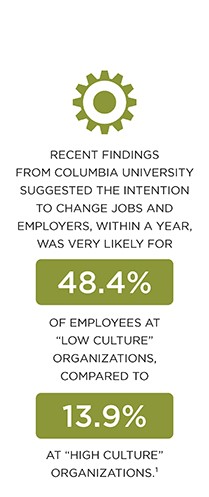By J. Patrick Gallagher, Jr.
A tight labor market creates pressure to offer the most expensive and extensive compensation and benefits. Under these conditions, resisting the urge to chase quick wins can pay off — if the long game is a focus on culture.
Compensation and benefit packages are easily matched or exceeded by competitors. When leadership centers their talent attraction and retention efforts on cultivating a better work environment and experience, they’re investing in a sustainable and profitable approach to talent management.
Research has explored the link between culture and business outcomes:

A competitive value statement
Good cultural intentions aren’t quite good enough in a competitive talent marketplace where younger generations are known to possess and express a “prove it” attitude — but a well-defined value statement makes a firm commitment. This proposition sets both employee expectations and employer guidelines for meeting them. For instance, it provides the foundation for a rewards package and employee programs that fully support recruitment, retention and cost management goals, as well as shareholder interests.
When employees and potential hires consistently experience these stated values, they’re more likely to feel a sense of belonging that builds trust and confidence in the organization. The value proposition is also a unifying force for aligning the hiring, promotion and succession planning processes. It helps attract people with the same ideals who are more likely to stay and grow with their employer.
Shared goals and vision for the future
A clearly articulated and communicated vision makes it easier for employees to relate their roles and goals to the organization’s mission. To keep this connection meaningful, employers should look ahead to the needs of the next workforce generation. Investing in technologies and analytics to periodically measure and address evolving workforce priorities will continually transform the culture, and drive performance.
This focus is about helping employees see what’s ahead of them and establishing the plans, partnerships and other support they need to face their futures with confidence. When this happens, they become more engaged and better able to withstand external disruptors like changing economic conditions. In a recent survey analysis, organizations that ranked as top performers — at managing both healthcare costs and HR — excelled at making sure employees know their individual contributions are valued.²,³
Closer alignment of incentives
An integrated approach to supporting employees’ health, career interests and financial needs is a compelling bid for attracting highly qualified talent. Prospective candidates recognize the underlying compensation and benefits as a commitment to an exceptional employee experience. And integrating succession planning into talent management further enhances retention efforts and results. It’s important to identify and define roles, make good use of data, and institutionalize talent development and career wellbeing to keep growth opportunities strong.
Healthcare benefits are still in high demand with no cost relief in sight. And now that cost shifting to employees is a greater deterrent to securing talent, employers need to home in on the unique drivers of their healthcare spend. Directly addressing these drivers helps keep benefits affordably attractive.
At the far end of the employment time span, retirement has been slowed by lack of financial readiness. Employers will be better able to counter these trends if they connect employee and organizational wellbeing with methods and resources that build resilience. Repositioning existing benefits and adding affordable, newer options can provide cost-effective solutions.
Total rewards form the backbone of a culture that promotes affinity. The more closely they align with workforce demographics and job types, the more strongly they appeal to employees — and serve as reliable attachment points to the organization.
J. Patrick Gallagher, Jr.
Chairman, President and CEO
Arthur J. Gallagher & Co.
